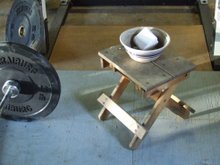
This squat bar is designed to balance the load directly through the midline, freeing the shoulders to be in safer positions than the straight bar allows. The shoulders are not forced into the vulnerable position of exaggerated external rotation and partial flexion in the frontal plane, which is a common culprit in longterm shoulder injuries for lifters, states its originator, famous Fred "Dr. Squat" Hatfield, the first man to squat 1,000 pounds. "For lifters such as me, this position is so damaging that if it weren't for this particular bar, I would never squat again. I'm a big personal fan of this bar design, and believe every gym should carry one," says Hatfield. In fact, most owners of this bar come to find it specifically because their shoulders can no longer tolerate the position the straight bar forces them into. "The bar has two pegs laying perpendicular to the main bar which rest across the meat of the tops of the upper trapezius muscles. This is where the load is focused, and the bar is balanced. The bar does not need to be held with the arms and hands, as a straight bar does. Forward or downward angles on each end draw the weight into balance" (Hatfield). The lifter is free to move his/her arms, even to grip the squat cage and self-spot, and he/she is not pitched forward as much as with the straight bar, thus protecting the spine.
Various equipment companies offer bars based on Hatfield's design. Although there are pretty standard measurements for the majority of users, these bars can be made custom-made to fit the individual, especially good for smaller framed lifters such as myself. I got my custom-made bar from Sorinex at www.sorinex.com. Ten years later, no structural problems, but the powder coating is wearing off the points of contact with plates and rack.
(around $400)
Safety Squat Bar
Labels: injury fix, thumbs up, weightlifting
Subscribe to:
Post Comments (Atom)




1 comment:
Hey thanks for the article. I've never seen this safety squat bar before, but it is a great idea.
Post a Comment